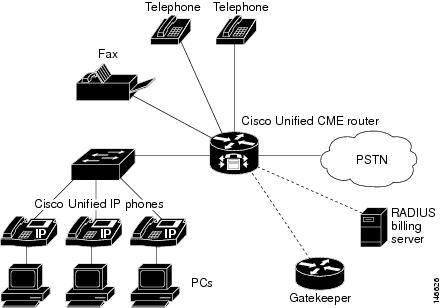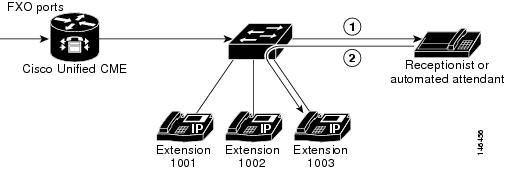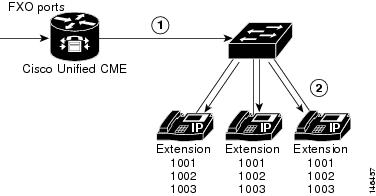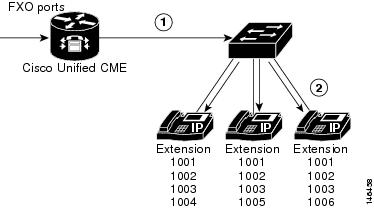The Cisco Unified CallManager Express (CME) solution not only has the benefit of voice-data integration on a single platform, but offers also flexible deployment options. The Cisco CME on its basic form consists of a router on which the callmanager software is installed, plus several telephony devices. The CME router acts as a gateway between the Public Switched Telephone Network (PSTN) and your local IP telephony network. IP Phones or other legacy telephony devices can be connected on the Call Manager Express router (either directly using FXS ports, or on the local LAN switch). The figure below shows a basic small-office/medium-office CME network topology (figure is from Cisco):

The typical CME deployment above uses a single callmanager router with few legacy telephony devices (normal telephones and a Fax machine) connected directly on the router itself (on FXS ports), plus few IP Phones connected on the local LAN switch. All these phones are controlled by the CME router.
The Cisco CME software uses the following basic building blocks:
- Ephone: This is configured in software (using IOS commands on the router) and represents a physical telephone. The MAC address of each physical phone is configured using the ephone configuration commands.
- Directory Number: This is again a software concept that represents the line that connects a voice channel to a phone. A directory number represents a virtual voice port in the Cisco Unified CME system.
Call Manager Express Call Handling Modes
Before deploying a Call Manager Express system you must decide how the system will handle calls. There are three call handling models: PBX model, KeySwitch model or Hybrid model.
PBX Model:
This is the simplest and most popular call manager mode of operation. Each internal telephone has its own unique directory number (extension number) as shown in the diagram below.

Incoming PSTN calls are usually routed by the CME router to a central receptionist (or auto-attendant) which then delivers the calls to the appropriate requested extension number. There is also the option of having Direct Inward Dialing (DID) lines towards the PSTN which allows incoming PSTN calls to be directly routed to specific internal extensions. An example of DID is when calls coming to number 555-838-1001 will be routed directly to Extension 1001, calls coming to number 555-838-1002 will be routed to Extension 1002 etc.
It is recommended for this model that you configure directory numbers as dual-lines so that each button that appears on an IP phone can handle two concurrent calls. Dual-line directory numbers enable your configuration to support call waiting, call transfer with consultation, and three-party conferencing (G.711 only).
Keyswitch Model:
In this model there is no central receptionist telephone. Rather, all telephones have an identical configuration in which each phone is able to answer any incoming PSTN call on any line. An example is shown below:

The keyswitch model is configured by creating a set of directory numbers (Extension numbers) that correspond one-to-one with your PSTN lines. Then you configure your PSTN ports to route incoming calls to those directory numbers. When an incoming PSTN call arrives (e.g on Extension 1001), then ALL telephones will ring on line 1001. Any user can then pick-up the ringing line by just pressing the button corresponding to that line.
Hybrid Model:
In this model, each IP phone can have both PBX and Keyswitch configurations. Each telephone can have unique extension numbers (PBX model) and also shared lines numbers (keyswitch model).

A hybrid model is shown above. Extension numbers 1001, 1002, 1003 are shared lines, and Extensions 1004, 1005, 1006 are unique private numbers for each user.